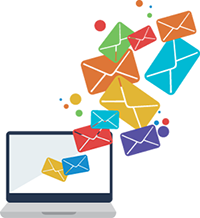Developing A Strong Email Marketing Strategy

Effective Email Marketing
If you received an email in 1995, both you and the sender were on the cutting edge of communication. Now, 20 years later, over 122 billion emails are sent every hour. Whether these billions of emails are judged as being necessary or nuisance, electronic messages are an undeniable staple of business communication. The challenge for marketers is to keep email interesting and effective.
Email marketing can and should be a strategic tactic in lead generation and ongoing customer engagement. According to research, 68% of companies report that email marketing is core to their business. Companies who employ successful email marketing campaigns maximize efforts across four distinct stages—collecting, connecting, converting and circulating.
Steps To Developing A Strong Email Strategy
The collecting phase focuses on acquiring leads and contacts. During the collection process, companies should be constantly adding new leads through the use of web landing pages and opt-in forms. The old adage garbage in, garbage out applies here. The opt-in is a critical component to a successful campaign because it helps to grow a database of qualified customers or clients.
During the connecting phase, the emphasis is on building a relationship with prospects and identifying any unique interests or characteristics that will help move the sales process forward. Follow-up is critical to making good connections. Delivery analytics should be used to help monitor email open rates, click-through-rates and other important metrics. Companies need to be careful not to fall into the trap of equating the size of their email database with total impact. The response rates are the true measure of success.
Once the email messages have been communicated, it’s time to begin to build a relationship with prospects, working to convert them into customers. Offering individuals, who visit web landing pages, relevant content like white papers or research reports will help them become engaged and move from being prospects to customers. Relationships that have been nurtured through solid lead generation tactics, relevant content and a strong online presence should result in qualified sales calls or actual purchases.
In the final marketing phase, circulating, companies should pay close attention to maintaining relationships with prospects and customers. Ninety percent of businesses “drop the ball” in terms of maintaining relationships with valuable prospect and customer groups because they aren’t focused on creating a positive ongoing relationship. Disorganized, inconsistent methodologies for maintaining engagement, retention and future purchases can be a problem. So can blasting generic emails that blanket everyone on the list, instead of targeting specific groups with tailored messages.
